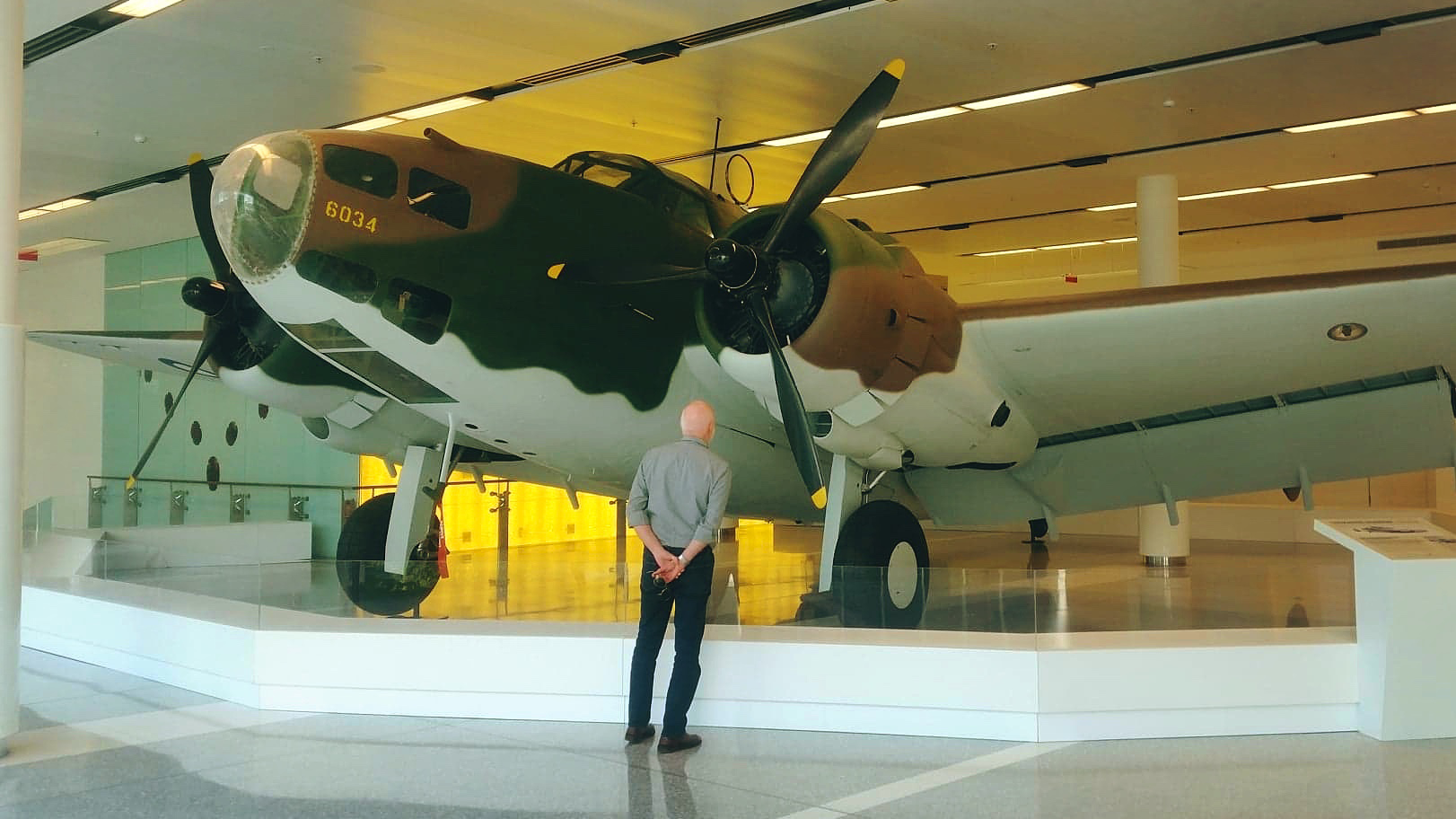War and Peace: object biographies and aviation heritage
Like most Canberra-based academics I spend quite a bit of time in airports. Since beginning work on the Heritage of the Air ARC Linkage project in February this year, I’m also getting to know airports as places in their own right, with their own particular histories and distinctive liminal spaces. With both a national and transnational focus, a key partner for our project is the SFO Museum, a really exciting example of a cultural place, art gallery and aviation heritage museum, all embedded in the place, space, time and culture of San Francisco’s busy international airport. I therefore watched the development of Canberra’s new international airport with great interest over the last few years as we planned and designed the Heritage of the Air project. In December 2016, an impressive new exhibit appeared in the new airport, looming over the generous space at the Virgin check-in end of the terminal – a restored Lockheed Hudson Mk IVA, A16–105, owned by the Australian War Memorial.
I finally took the time to have a good look at the plane recently, in the company of someone who knows a thing or two about historic aircraft restoration. “What do you think of the restoration?” I asked. “Good – accurate job” he said, and pointed out some details to me, such as how the window Perspex was cut away for a waist-mounted machine gun and how the antenna arrays had been reinstated along the fuselage.
It looked very ‘complete’ to me- a ‘total concept’ restoration focusing on one particular point of time in the past. But one that clearly tells an important and poignant story to a knowing observer such as my companion. A story about the Royal Australian Air Force in WWII, about the strategic importance of the Hudson aircraft and the pilots and crew who flew them in tough conditions in New Guinea, associated with operations around the Buna-Gona and Sanananda region.
The object biography of this Hudson can be charted in great detail – it arrived in Australia from the USA in 1941 and flew several missions in Papua New Guinea before being recalled in 1943. In 1947 it was sold to European Air Transport and began its long peace-time career working in civil aviation. In 1954 a skillful pilot, Captain Ron Walesby, averted disaster and saved the lives of the nine aboard when the Hudson suffered a wheel collapse on landing in Brisbane. The Courier Mail recorded that within two minutes of the plane coming to a halt after spinning across the runway, the ‘pretty, auburn-haired hostess, Miss Claire Bailey, had shepherded the plane’s six passengers out of the cabin’. In 1962 the hardworking Hudson was sold to John Fairfax and Sons, which leased it to Adastra Aerial Surveys. The plane then had an aerial survey camera mounted and even had a dark room installed in its cabin. Withdrawn from service in 1971, the veteran was put out to pasture. But as early as 1976, evidence of the Hudson’s 30-year civil aviation service began to be erased as new owners worked to return the plane to its wartime configuration.
Heritage of the Air is a project that doesn’t just aim to chronicle the history of civil aviation but to interpret the experience and impact of this transformative industry through its material culture and the heritage of its physical infrastructure. And part of this story is how individuals and groups have collected, curated and cared for this heritage, and how they have told its stories. While the interest in civil aviation in Australia is enormous, the story of this Hudson illustrates some of the challenges we face in linking the material heritage of the air to a narrative of peace-time life. Every trace of the Hudson’s 30 years of peace time experience has been erased by its restoration to commemorate its 2 or 3 years of military service. My point here is not to criticize these actions but take this as an ‘object lesson’ for some of the challenges we face in this research project. Aviation history is massively dominated by a focus on airpower in WWI and II- a technological drama, with highest possible stakes, animated by charismatic risk-takers and heroes. How is the history of peace time, day-in day-out work of aviation remotely comparable?
As in other nations, Australian cultural memory and our memory institutions continue to focus on the twentieth century’s two world wars as crucibles which forged national character and on the narratives which engender empathy for the suffering and altruism of the ordinary men and women caught up in these events. How can we narrate the significance of the quotidian, everydayness of 30 years where nothing much happened? A period where drama was avoided due to a remarkable assemblage of people and technology that transformed the way in which communities in Australia understood their place in national space and their sense of the planet as a place. Can we even imagine a time when the Hudson might have its aerial survey camera and dark room reinstated – as we perhaps rethink how aerial survey changed the way the nation imagined itself in the post-war period, making borders amenable to surveillance and control, making it conceivable that workers would travel thousands of kilometres week-in, week-out?
The history and material culture of aviation are ripe for new perspectives that can connect communities to the ‘vibrant matter’ of aviation heritage. We hope that our research, involving artefacts, images, memories, collections and collaborations, will produce a richer and more inclusive ‘heritage of the air’.


This restoration, focusing on the Hudson’s military service, just goes to show that military aviation history is perceived (by some at least) to be of greater significance, and interest, than civil aviation history.
such as how the window Perspex was cut away for a waist-mounted machine gun and how the antenna arrays had been reinstated along the fuselage.
how long has the aircraft not been used?